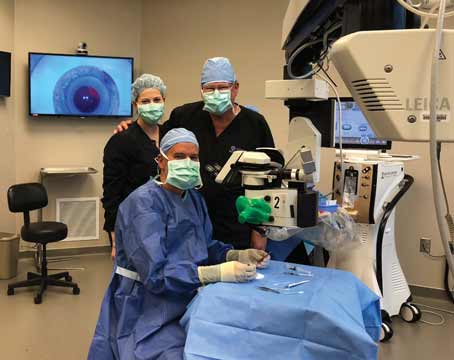Cloud computing is not new, and most of us use these services every day. For example, many e-mail services (Yahoo mail, Gmail, Hotmail) and information-sharing services (Google Docs) operate in the cloud. True cloud computing allows users to access information over the Internet from any computer with an Internet browser.
Although no electronic health record vendors in ophthalmology are currently offering true cloud computing, they do offer a Web-hosted option. “People put a lot of things in the bucket of cloud computing, including ‘Web-hosted,’ where the EHR application resides remotely on the EHR vendor’s servers and can be accessed by practices over the Web using a remote desktop client of some sort,” says Mary Ann Fitzhugh, vice president of marketing, Compulink Business Systems.

With the Web-hosted option, the application is running on servers located in a secure data center rather than in the ophthalmologist’s office. Users then access the application through a Web browser or by special-purpose client software provided by the vendor. The vendor is responsible for backing up the data and managing the server, including all updates to the software. The vendor is also responsible for providing secure, HIPAA-compliant storage of all patient data.
A key benefit of implementing EHR as a cloud solution is simplicity. Vendor management of the server reduces the need for offices to have dedicated IT expertise and the cost associated with that support. Hosted solutions also simplify access, providing users with the ability to access patient data when they are outside of the office. Other benefits include improved reliability, system availability, ease of adding new users and security.
However, while cloud computing sounds like a good way to reduce the overall IT complexity of implementing EHRs, several factors need to be taken into consideration when deciding whether to bring your EHR systems in-house or to choose a web-hosted option. The size and location of your practice and your financial situation are two important factors to consider.
Cost
When weighing the options, ophthalmologists need to determine which one makes sense financially. With the in-house (client-server) option, the product is purchased up-front, it is set up in the ophthalmologist’s office, and the office is responsible for backing up the data and maintaining the server. With the Web-hosted option, ophthalmologists pay a monthly fee for these services.
“You never really buy the product. It makes the up-front installation setup less expensive and easier because you don’t have to go out and buy a server, install a server, and then worry about how to support that server,” explains Jim Messier, vice president of sales and marketing, Medflow, Inc.
For smaller practices especially, this option makes sense. The larger the practice, the less sense it makes to go to a cloud environment, according to Mr. Messier.
For the client-server option, the up-front fee is typically $35,000, and there is a low monthly fee that is paid to the software company for monthly expenses. With the Web-hosted option, the monthly fee is typically $650 to $800 for as long as you use the product.
“You’ve got to really look at the numbers. In a hosted environment, you are not going to have to make the investment to purchase the server hardware or the third-party software. There is savings on the initial purchase, but if you look at things over a five-year and a 10-year period, at about five years, you break even. If you just look at paying $35,000 up-front versus $800 a month, anyone would go for the $800 solution, but you are not purchasing it for just one month. An EHR is a long-term commitment of five, seven or 10 years,” Mr. Messier says.
For smaller practices that may not have an internal IT expert, there may be additional financial benefits. “The biggest advantage of the Web-hosted option is that it gets you out of the IT business,” Ms. Fitzhugh says. “With the software and the servers located in your office, you’re going to need the IT expertise to maintain and manage those resources. You’re going to be responsible for managing everything from complex data backup plans to ensuring you can pass a data security audit. With Web-hosting, all of this is your vendor’s problem to solve.”
Additionally, in a hosted environment, the vendor is responsible for all computer updates. “When a manufacturer changes or updates a piece of software, it either sets up something where you download the data or it sends you a CD,” says Kevin Corcoran, an ophthalmology practice management consultant based in San Bernardino, Calif. “You have to do all of the computers in your office one at a time in the client-server model. In the cloud, all of the software is updated at once by someone else. All updates will be done for you, saving you time and money. Also, if your practice grows, it’s a lot easier to add new computers to your office if you operate in the cloud than if you have to buy hardware and install it.”
Security
Security is a concern with both options and needs to be taken into account. If the server is in your office, you have better control over who has access to the data, and you can access the data anytime. “If it’s in the cloud, who has it, where is it, and who might be looking at it? That’s the extreme, but it’s also reality,” Mr. Messier says.
Mr. Corcoran agrees, noting that physicians are giving up control of their data: “Now that your data is on someone else’s computer, can you guarantee security? Clearly, that’s a big concern. If you have a disagreement with the vendor, will they snip the umbilical cord, and you will lose access to your data. What if you don’t pay someone, for example? Do they hold you hostage by saying, ‘If you want your data, pay our bill?’ ”
Of course, data may not be secure in the ophthalmologist’s office, either. Mr. Corcoran knows cases where one partner in a multi-physician practice stole another physician’s data. There have also been instances where a server is destroyed and the backup system fails. When it comes to data safety and security, there are no true guarantees if you do it yourself.
The Pros and Cons
There are several drawbacks to the client-server model, especially for smaller practices, according to Michael Chiang, MD, who is professor of ophthalmology and medical informatics at the Casey Eye Institute at Oregon Health and Science University and chair of the AAO Medical Information Technology Committee. One of the difficulties of implementing EHRs for small practices is that they may not have the technical resources or infrastructure to implement these systems, and they may not have an IT person to maintain the system. “For smaller practices, you could make the argument that cloud-based systems really make sense because the implementation is simple. For true cloud-based systems, you only need a computer and good web access,” he says.
While servers are not large, they are not easy to keep in-house. “For example, you have to make sure that the area is physically secure, meaning that someone can’t just walk in and steal data from the machine or inadvertently place corrupted files on the machine,” Dr. Chiang says. “Additionally, the servers need to be physically secure in the sense that if there is a flood or a fire or some other type of disaster, the machine must be protected as much as possible. For example, it has to be mounted somewhere safe.”
Additionally, all data must be backed up. “If the machine crashes in the middle of the day, there must be a redundancy mechanism so that you don’t have to close the office,” he adds. “There also needs to be a backup mechanism so that, if the machine breaks or if the room floods, you have a copy of everything at an off-site location to prevent permanent loss of data.”
Servers must also be kept in a controlled environment. Because they generate heat, they must be stored in rooms that are temperature-controlled. Particularly if your practice is located in an older building, ventilation and air conditioning modifications may be required. “All of those things can be really time-consuming and expensive,” says Dr. Chiang. “That is difficult for any practice, but especially smaller practices that may have limited space and limited resources. Operating in the cloud gives others the responsibility of handling those things for you.”
There are several drawbacks to computing in the cloud, also. Although the hosting companies guarantee functionality and reliability, there have been cases where cloud-based servers have crashed. For example, in April 2011, thousands of businesses and major websites crashed after an Amazon cloud failure. “A lot of people, including large corporations, used this cloud-based system for their storage,” Dr. Chiang says. “When that crashed, people weren’t able to get access to their data and were taken off-line for a while. No system is 100-percent bulletproof.”
Including client-server models. During Hurricane Katrina, hospitals were flooded, and many patients’ paper-based medical records were destroyed. “That case demonstrated a major benefit of EHRs because VA patients who had their data stored in EHRs had their data backed up off-site and were able to get back to normal medical care within a few days,” he adds.
Ms. Fitzhugh adds that ophthalmology is a particularly difficult specialty for Web-based solutions because of the complexity of the ophthalmic environment. “Just trying to integrate all of the diagnostic equipment with the EHR software over the Web can be challenging; some equipment simply cannot be supported,” she says. “Additionally, pushing images back and forth into the cloud requires network bandwidth that offices might not have available locally. Ultimately, I think everyone wants everything to be in the cloud because that will relieve practices from needing IT expertise and maintaining all these servers on the premises, but the technology needed to support pure cloud is not quite ready for prime time.”
Mr. Messier notes that EHRs are only as good as their weakest link, which is often the Internet connection in Web-hosted situations. “Connections are getting better and better,” he says, “and they are certainly better than they were 10 years ago, but they are the weak link. Ophthalmologists need a fast connection and some type of backup connection that is in place so that if the primary goes down, they are still able to function in their offices.”
He notes that an upgraded Internet connection is often not considered in the cost analysis, but it should be. “In eye care, even if you are a one-doctor practice, you are probably going to have between three and seven pieces of diagnostic equipment, so in order for you to have a fully functional EHR, you need to have that diagnostic information and those images internal to your charting. The challenge there is, in a cloud environment, we need to be able to take that information and store it to the server. You have to have the bandwidth to be able to upload this information and the modality to store it onto the server so that you can walk into the exam room, look at those images, and be able to make your treatment decisions without any hesitation and without any delay,” he says.
While there are many considerations when choosing between the client-server model and the Web-hosted model, the cloud is the way of the future. “The trend is clearly toward the cloud,” says Mr. Corcoran. “Not everybody is sold on the idea, but I wouldn’t be spending lots of money on servers if I was the CEO of a physician practice management company.”






